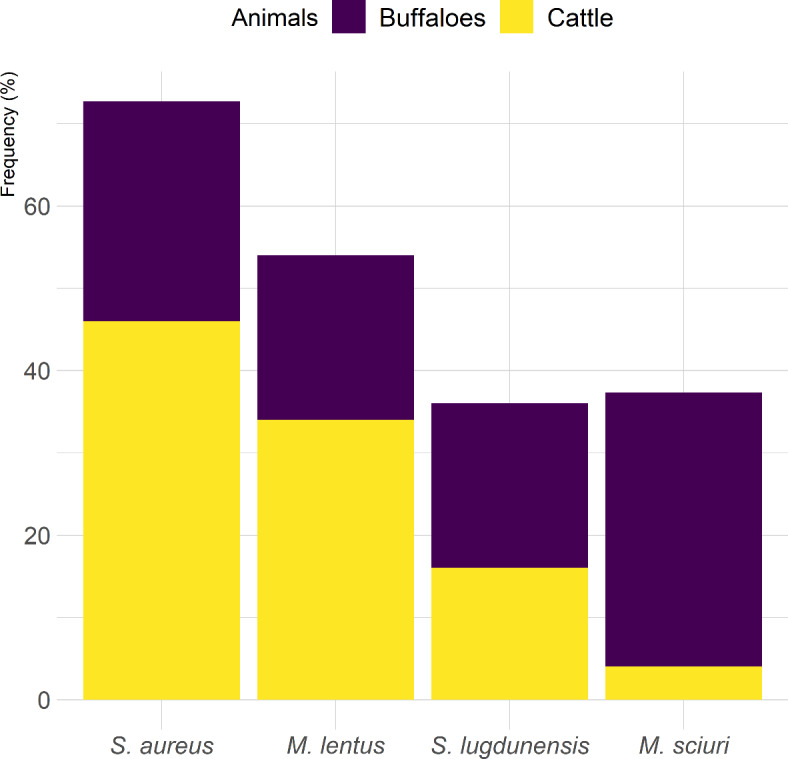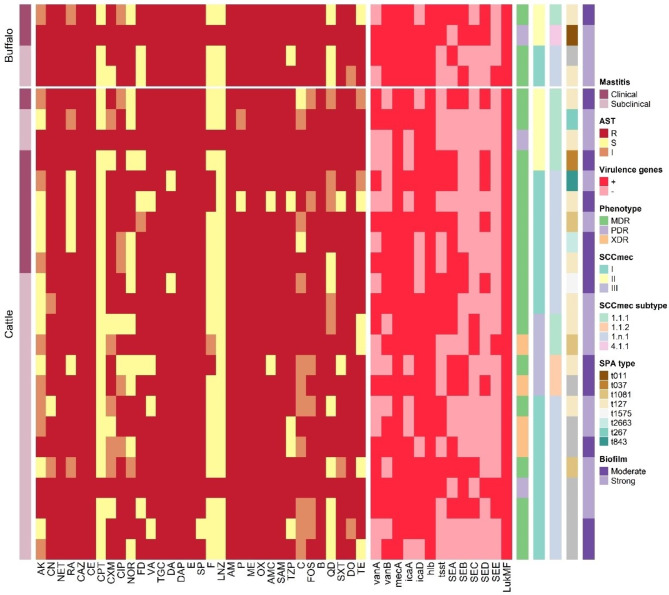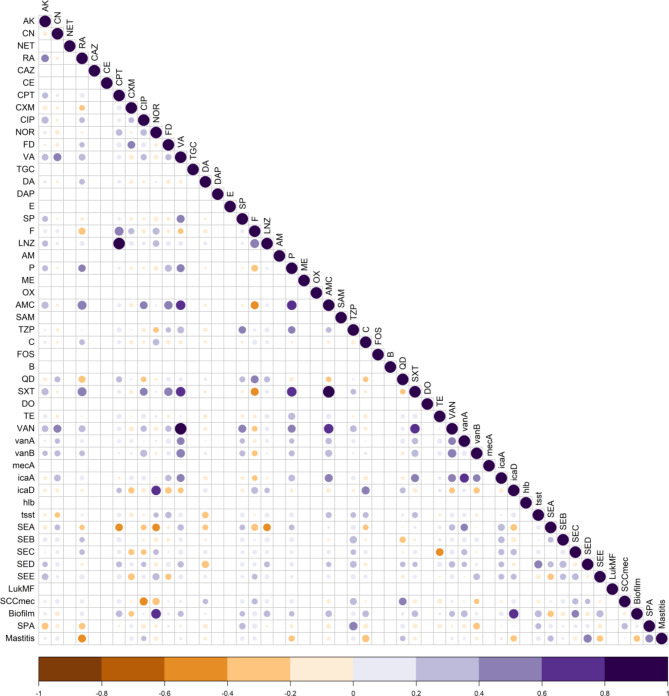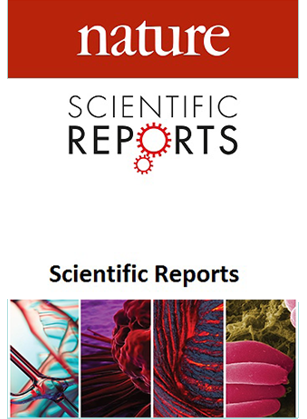耐万古霉素金黄色葡萄球菌危及埃及奶牛群。
摘要
牛乳样品中出现的耐甲氧西林和耐万古霉素金黄色葡萄球菌(MRSA和VRSA)分离株以及生物膜形成能力和携带各种毒力基因,使牛乳腺炎的治疗复杂化,并突出了对公共卫生的严重威胁。本研究首次对埃及临床和亚临床牛乳腺炎分离的MRSA和VRSA的频率、耐药谱、生物膜形成能力、毒力因子、spa和葡萄球菌盒染色体mec (SCCmec)类型进行了研究。从202头奶牛(包括31头水牛和171头牛)每个季度共采集了808份牛奶样本。水牛乳腺炎发生率为48.4%(60/124),牛乳腺炎发生率为29.2%(200/684)。共检出葡萄球菌65株,其中凝固酶阳性金黄色葡萄球菌(cop) 27株,凝固酶阴性葡萄球菌(con) 38株。其中乳球菌27株(乳杆菌20株,猪链球菌7株),非金黄色葡萄球菌11株(卢顿葡萄球菌)。所有cop菌株均为mecA阳性,对20 ~ 33种抗微生物药物耐药,多重耐药指数在0.61 ~ 1之间。3株为PDR, 4株为XDR, 20株为耐多药菌株。85.2%的cop分离株检测到VRSA,最低抑制浓度(MIC)为64 ~ 1024µg/mL。60.8%的VRSA分离株中存在vanA基因,73.9%的VRSA分离株中存在vanB基因,43.5%的VRSA分离株中存在vanB基因。所有菌株均具有生物成膜能力,其中55.6%为强生膜菌,44.4%为中等生膜菌,并携带icaA(74.1%)和icaD(74.1%)生物成膜基因。所有金黄色葡萄球菌均含有β -溶血素(hlb)和白细胞毒素(lukMF)基因,44.4%的金黄色葡萄球菌中毒性休克综合征毒素(tsst)基因阳性。肠毒素基因sea、seb、sec、sed和see分别占59.3%、40.7%、18.5%、33.3%和14.8%。此外,70.4%的分离株具有spa x区基因,并表现出8种不同的MRSA spa型(t127、t267、t037、t011、t843、t1081、t2663和t1575),其中以spa t127最为常见。SCCmec有3种类型(I、II和III),以SCCmec I型为主,进一步分为1.1.1、1.1.2、1.n亚型。1、4.1.1。MRSA和VRSA分离株产生生物膜和抵抗抗菌素的能力凸显了这些病原体对牛奶安全、动物福利和公共卫生构成的严重威胁。因此,严格的卫生习惯和抗菌素监测对于降低MRSA和VRSA定植和传播的风险至关重要。



The emergence of pandrug-resistant (PDR) and extensive drug-resistant (XDR) methicillin-resistant and vancomycin-resistant Staphylococcus aureus (MRSA and VRSA) isolates from bovine milk samples along with biofilm formation ability and harboring various virulence genes complicates the treatment of bovine mastitis and highlights the serious threat to public health. This study investigated for the first time the frequency, antimicrobial resistance profiles, biofilm-forming ability, virulence factors, spa and staphylococcal cassette chromosome mec (SCCmec) types of MRSA and VRSA isolated from clinical and subclinical bovine mastitis in Egypt. A total of 808 milk samples were collected from each quarter of 202 dairy animals, including 31 buffaloes and 171 cattle. The frequency of mastitis in the collected milk samples was 48.4% (60/124) in buffaloes and 29.2% (200/684) in cattle. A total of 65 Staphylococcus species isolates were recovered, including 27 coagulase-positive S. aureus (CoPS) isolates and 38 coagulase-negative staphylococci (CoNS). The CoNS included 27 mammaliicocci (20 Mammaliicoccus lentus and 7 M. sciuri) and 11 Non-aureus staphylococci (S. lugdunensis) isolates. All the CoPS isolates were mecA positive and resistant to 20-33 tested antimicrobials with multiple antibiotic resistance index ranging from 0.61 to 1. Three isolates were PDR, four were XDR, and 20 were multidrug resistant isolates. VRSA was detected in 85.2% of CoPS isolates with minimal inhibitory concentration (MIC) ranging from 64 to 1024 µg/mL. The vanA gene was found in 60.8%, vanB in 73.9%, and both genes in 43.5% of VRSA isolates. All the CoPS isolates exhibited biofilm formation ability, with 55.6% being strong, and 44.4% moderate biofilm producers, and harbored icaA (74.1%) and icaD (74.1%) biofilm-forming genes. All S. aureus isolates harbored both beta-haemolysin (hlb) and leucotoxin (lukMF) genes, while 44.4% were positive for toxic shock syndrome toxin (tsst) gene. Enterotoxin genes sea, seb, sec, sed, and see were found in 59.3%, 40.7%, 18.5%, 33.3%, and 14.8% of isolates, respectively. Additionally, 70.4% of the isolates had spa X-region gene, and exhibited eight different MRSA spa types (t127, t267, t037, t011, t843, t1081, t2663, and t1575), with spa t127 being the most common. Three SCCmec types (I, II and III) were identified, with SCCmec I being predominant, and were further classified into subtypes 1.1.1, 1.1.2, 1.n.1, and 4.1.1. The ability of MRSA and VRSA isolates to produce biofilms and resist antimicrobials highlights the serious threat these pathogens pose to bovine milk safety, animal welfare, and public health. Therefore, strict hygiene practices and antimicrobial surveillance are crucial to reduce the risk of MRSA and VRSA colonization and dissemination.

 求助内容:
求助内容: 应助结果提醒方式:
应助结果提醒方式:


